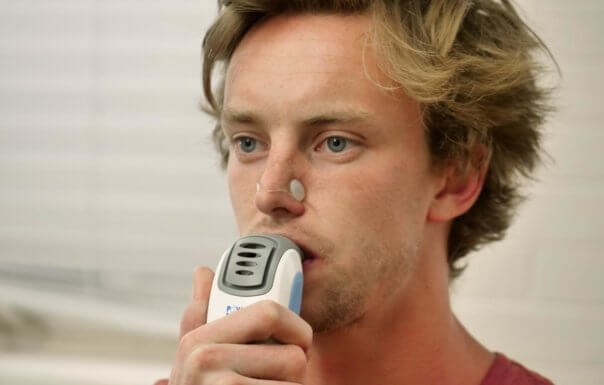5-minute breathing exercise lowers blood pressure better than working out, medication
BOULDER, Colo. — A five-minute workout that scientists call “strength training for your breathing muscles” is proving to lower blood pressure as well as or even better than traditional exercise and prescription drugs. Researchers from the University of Colorado-Boulder say this groundbreaking exercise makes use of a hand-held device which provides resistance as the user breathes. Simply put, as you suck in air, the tube tries to suck it back in.
Researchers call this technique High-Resistance Inspiratory Muscle Strength Training (IMST). Although doctors in the past have recommended patients with breathing disorders use these devices at low power for about 30 minutes, the new study finds a five-minute, high-intensity burst can improve cardiovascular health among older adults.
In the United States, estimates show nearly two-thirds of people over age 50 have elevated blood pressure. This puts many of them at risk of suffering from heart disease, heart attacks, or a stroke. Moreover, researchers say less than half of these Americans are getting enough exercise to improve their condition.
“There are a lot of lifestyle strategies we know can help people maintain cardiovascular health as they age. But the reality is, they take a lot of time and effort and can be expensive and hard for some people to access,” says lead author Daniel Craighead in a university release. “IMST can be done in five minutes in your own home while you watch TV.”
Blood pressure exercise better than walking every day
Scientists originally developed IMST in the 1980s to help critically ill patients deal with respiratory diseases. By inhaling vigorously through the device, a patient can strengthen their diaphragm and other breathing muscles thanks to the resistance the IMST creates in the body.
Unlike the low-level workouts for sick patients, study authors examined a group of 36 healthy adults between 50 and 79 years-old. These participants all had a systolic blood pressure (the top number) above the normal level of 120 mm/Hg.
During the study, half of these adults did 30 inhalations per day at high resistance six days a week for six weeks. The other half did a “placebo” exercise, featuring a much lower resistance setting on the device.
Results show participants in the IMST group saw their systolic blood pressure fall by an average of nine points. That kind of improvement, researchers say, is generally better than what high blood pressure patients see from walking 30 minutes a day five days a week. The study finds the IMST results are even on par with certain blood pressure-lowering drugs prescribed to patients.
Perhaps more importantly, study authors find people doing IMST saw their blood pressure continue to stay low even after they stopped the breathing workouts for six weeks.
“We found not only is it more time-efficient than traditional exercise programs, the benefits may be longer lasting,” Craighead adds.
Additionally, IMST patients experienced a 45-percent improvement in vascular endothelial function — or the ability for the arteries to expand. Participants also had a significant increase in their levels of nitric oxide, which is key to the arteries dilating and preventing plaque from building up. The team adds markers for inflammation and oxidative stress decreased as well.
A better alternative for older women?
The study finds this quick breathing workout may be a great alternative to exercise for one group in particular — postmenopausal women.
Senior author Doug Seals’ lab discovered that postmenopausal women taking supplemental estrogen don’t reap the benefits of aerobic exercise as much as older men do. This is especially true for vascular endothelial function. The new report finds using IMST helps these women just as much as male participants.
“If aerobic exercise won’t improve this key measure of cardiovascular health for postmenopausal women, they need another lifestyle intervention that will,” Craighead says. “This could be it.”
On top of strengthening a patient’s breathing, researchers say the early results show IMST also impacts a user’s brain function and overall fitness too.
“If you’re running a marathon, your respiratory muscles get tired and begin to steal blood from your skeletal muscles,” Craighead, an assistant research professor in the Department of Integrative Physiology, explains. “The idea is that if you build up endurance of those respiratory muscles, that won’t happen and your legs won’t get as fatigued.”
For now, it’s still unclear how exactly IMST directly contributes to lowering blood pressure. The team suspects this kind of resistance training sparks the cells lining blood vessels to produce more nitric oxide. This enables a user to relax.
“It’s easy to do, it doesn’t take long, and we think it has a lot of potential to help a lot of people,” Craighead concludes.
The findings appear in the Journal of the American Heart Association.





Recommended Comments
Join the conversation
You can post now and register later. If you have an account, sign in now to post with your account.
Note: Your post will require moderator approval before it will be visible.